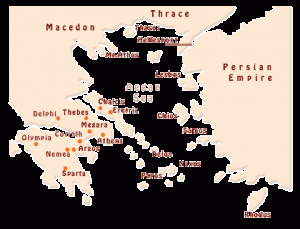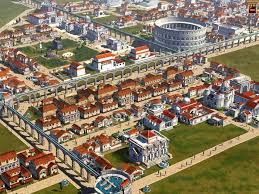Greek Polis, in ancient Greece, was typically a social structure or a community structure which consisted of an urban center with a sacred center built on a natural Acropolis. This Acropolis controlled the surrounding territory.
Polis is basically translated into a city-state. Ancient Greece was actually a collection of different polis i.e. city-states. Each polish was completely different than others except that they had a common Greek background.

What is a Polis?
Polis was the ancient Greek units of sovereignty or states which functioned just like countries. It consisted of an urban complex and then the surrounding agricultural hinterland. Polis is a Greek word that is translated to English as a city-state.
Every polis was typically just one city but each city had its own political, judicial, legal and religious systems. Hence each polis was apparently an independent state. This independent polis would indulge in trade and international affair with other polls as well as other countries mostly via the sea.
The largest polis or city-state was the Athenian Polis. Other significant policies were Sparta, Corinth, Aegina, Rhodes, Thebes, Elis, Argos etc. There were in total more than 1000 poles in ancient Greece.

All the polis had some things in common. Almost all police had a common place where all the citizens would gather to discuss political issues. All citizens only included men. The other common aspect of various police was that they would have a common place for religious worship.
Mostly these places of public gatherings were at the Acropolis. The agora was a marketplace in the policies which was more often than not used for socializing within the community.Hence, Policies were like the building blocks of Ancient Greece.
Reasons for the rise of Polis
City-state or Poleis as the Greeks called it emerged around the Classical period of Ancient Greece. It originated when tribal systems broke up during an economic decline. These splintered tribal groups established themselves as independent states when their population grew.
Due to the geography of Ancient Greece, the states grew up quite distantly with the sea as the main outlet of communication which resulted in varying types of cultures growing in different city-states with their own form of governments and political form.
There were around 1000 city-states all over the Greek mainland and also scattered islands around the main mass of land. These were almost like countries with very different cultures, political and economic structures, ways of worship, etc. The only common similarity among the states is the Greek language spoken by all in the area. The main reason for such differential growth of so many city-states in such a small area was Greek geography.
The Greek topography is very rough and mountainous with almost 80 percent of the land being mountains or highlands. This made communication between the states very difficult. On the other hand, communication with the foreign lands through the sea route was much easier and most states developed through trade in the Mediterranean. Such geography led to small areas of land growing into states and cities almost in isolation and thus the rise of so many states.
Polis and the Hoplites
Hoplites were the heavily armored infantry soldiers which became common in every state. Previously battle and war were mainly dominated by aristocrats on horses. But with the rise of a middle-income farming group, wealthy masses became involved in the wars breaking the monopoly of aristocrats.
War was a huge part of ancient Greek society which brought prestige and a sense of power, and so hoplites became a important part of ancient Greek society. So when they became involved in the war the aristocrats were forced to share certain political power and give at least the free wealthy men certain rights. It also led to the formation of formal states or as we know, polis.
Ancient Greece zones and their important city-states
1. Peloponnese the peninsula at the southern tip of Balkan Sea. It was connected to the Greek island by the Isthmus of Corinth. The Peloponnese was further divided into seven Ancient Greek cities the Achaea, Arcadia, Corinthia, Elis, Achaea, Messenia, Laconia, Argolis.
2. Central Greece- central Greece consisted of the following ancient cities of Aeniania, Attica, Boeotia, Doris. Euboea, Locris, Malis, Megaris, Oetaea, and Phocis.
3. Western Greece the ancient cities of Western Greece include Acarnania, Aetolia, Aparentia, and Dolopia.
4. Thessaly cities like Achaea Phthiotis, Magnesia, Histiaoetis, Panagiotis, Perrhaebia, Thessaliotis fall in the Thessaly region.
5. Epirus includes the following ancient Greece cities Athamania, Chaonia, Dassaretia, Molossia, Thesprotia, Paraguay, and Tymphaea.
6. Macedonia or Macedonia was an ancient kingdom of Greek which included the ancient Greece city of Pelagonia.
Elements of Ancient Greek Polis
A city-state or polis consisted of the following elements:
- A main urban city complex, which was the main center of trade and commerce, and the area of prosperity. Most of the wealthy free citizens lived here in the cities and the whole polis was governed from this urban area. It was also the area of art and crafting with the artist living in service of their masters.
- A surrounding rural hinterland that consisted of agricultural lands, mines, quarries, etc. The rural areas supplied most of the food to the population in the cities as well as the resources for trade and business.
- An Acropolis which consisted of all of the government and other important buildings. This was mostly placed on high ground or a large rock outcrop like in Athens which also provided protection to the administrators and the powerful. This is where most of the temples and places of worship were located.
- An Agora, which was the marketplace for the Polis. This was where all the trade and commerce took place. It was the main center of the transaction and the economy.
Important City-Polis
The number of city states in Ancient Greece was almost 1000 but records and information only about a few are available. These were the most powerful and influential in Greek world who attainedAth great prosperity. Some of the important city states were:
Athens
Athens is renowned for its contribution to the idea of democracy to the world. It created the worlds first democratic government. It was the birthplace not only of democracy but of great philosophers like Plato. Athens, as an independent city-state grew rapidly after the Greek dark ages. Athena was the patron goddess of the Athenians.
By 753 BC, Athens fell from hereditary magistracy to elected archonship and later under tyranny. It was after this tyranny that Athenians experimented with the democratic system of government. Moreover, it was a direct democracy characterized by the men meeting to discuss problems and reach solutions.
Although citizens had political rights in Athens, slaves and foreigners did not have any such rights. The concept of citizenship was important in ancient Greece. Education was also important to the Athenians although differentiation between males and females was clearly visible in all areas.
Sparta
The city-state of Sparta was a state in the Peloponessian region and had an oligarchic system of government. The state was ruled by a small group of warriors. Sparta was famous for its military strength. Spartans were brave, capable warriors. It was not a center of art and philosophy, unlike Athens.
The most important feature of Sparta is the importance given to warfare and military training, and its considered to be the best of its time. Boys were given training from the age of 7. Children were whipped and small fights were encouraged in order to make them capable warriors. Even the women were warriors. Spartan women were comparatively more independent.
Corinth
Corinth was characterized by the monarchical of government. It was a cultural and trade center. The city-state of Corinth undertook public works programs, built large aqueducts and created its own coinage. Megara was a coastal city-state.
They had fine schools and a well-developed education system. Megara had beautiful temples, gorgeous statues, and open-air theatres. They also established new towns. Argos, a monarchy was the center of trade and commerce. They also had great sculptures.
Thebes
Thebes was a bitter rival to Athens and Sparta, being a major military power who had even sided with the Persians during the Greco-Persian War.
It was known to be a bustling industrial city famous for its commercial activities and silk production. It had a prominent literary culture being the Centre stage of stories like Cadmus, Oedipus, Dionysus, Hercules.
Syracuse
Syrachid was a thriving metropolis in ancient times located on the south east coast of Sicily. It had a lot of temples dedicated to the Greek gods like Zeus, Apollo, and Athena which were funded by its rich aristocrats.
Megara
Megara was a very respected city in the Ancient Greek world. It was ruled by a monarch and even had public programs which generated employment.
It was mainly a trading city based on a thriving economy famous for its richly colored and beautifully designed fabrics. They had a fearsome army that almost rivaled the likes of Sparta.
There were also other very powerful and important city-states like Aegina, Argos. Rhodes. Elis, Eretria, etc.